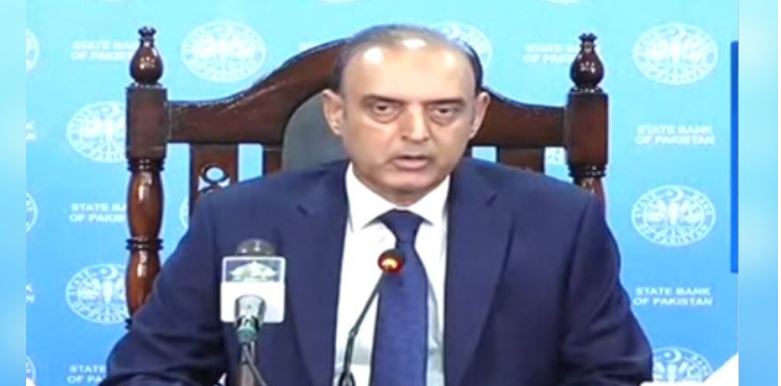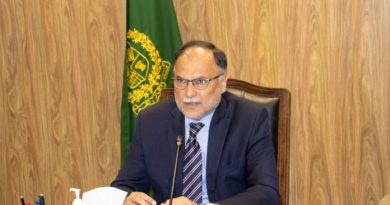State Bank keeps policy rate unchanged at 11%
APP
KARACHI: The State Bank of Pakistan (SBP) has announced to maintained the police rate at 11 percent, shooting down widespread hopes of a cut in the interest rate.
The announcement was made by SBP Governor Jameel Ahmad at a news conference in Karachi following a meeting of the State Bank’s Monetary Policy Committee (MPC) on Wednesday. “The MPC has decided to maintain the policy rate at 11%,” said Governor Jameel Ahmad.
The decision sank market expectations, which had anticipated a rate cut of around 50 to 100 basis points (bps).
The MPC noted that inflation in June 2025 decelerated to 3.2% year-on-year, led mainly by lower food prices, whereas core inflation also declined slightly. “However, the committee noted that the inflation outlook has somewhat worsened in the wake of higher-than-anticipated adjustments in energy prices, especially gas tariffs. Nonetheless, inflation is projected to stabilise in the target range going forward.
“Moreover, economic activity is gaining further traction amidst the still-unfolding impact of the earlier reductions in the policy rate,” read the MPC statement.
At the same time, the Committee noted that the trade deficit is expected to widen further in FY26 amidst the pickup in economic activity and slowdown in global trade. Given this macroeconomic outlook and the emerging risks, the MPC considered today’s decision as necessary to ensure price stability.
The Committee noted the following key developments since its last meeting. First, the SBP’s FX reserves crossed $14 billion on the back of improved financial inflows and a current account surplus. Second, the recent upgrade in Pakistan’s sovereign credit rating led to a decline in Eurobond yields and narrowed CDS spreads in international markets.
Third, inflation expectations increased slightly for consumers but declined for businesses in the latest sentiment surveys. Fourth, FBR tax revenue for FY25 was recorded at Rs11.7 trillion, which fell short of the revised estimate by around Rs200 billion. Lastly, global oil prices remained volatile, whereas metal prices increased. At the same time, the impact of global trade tariffs remained uncertain, prompting central banks to maintain their cautious monetary policy stance.
In view of these developments and potential risks, the Committee assessed that the real policy rate should continue to be adequately positive to stabilize inflation in the target range of 5 – 7 percent. The MPC emphasized on the need to continue the ongoing prudent monetary and fiscal policy mix to sustain macroeconomic stability. Moreover, the Committee reiterated its view that without structural reforms it would be difficult to achieve higher growth on a sustainable basis.
Real Sector: High-frequency economic indicators are depicting a gradual economic recovery. This is reflected in notable y/y growth in automobile sales, fertilizer offtake, credit to private sector, imports of intermediate goods and machinery, and purchasing manager’s index in recent months.
This improvement in high-frequency indicators has now also started to reflect in LSM data, which showed y/y increase in both April and May after five months of contraction. These trends indicate the improving outlook for the manufacturing sector. Barring flood-related risks, the agriculture sector is also expected to recover in FY26.
In particular, the outlook for major crops has somewhat improved from earlier expectations in the wake of better water availability due to recent rainfalls. Improving prospects for commodity-producing sectors will have positive spillover for the services sector as well. Supported by easing financial conditions, positive business sentiments and a gradually strengthening macroeconomic environment, real GDP growth is projected to rise to 3.25 –4.25 percent this year from the provisional estimate of 2.7 percent in FY25.
External Sector: The current account posted a surplus of $328 million in June, bringing the cumulative surplus to $2.1 billion (0.5 percent of GDP) in FY25. Workers’ remittances remained instrumental, as they more than offset the widening trade deficit. On the financing front, a sizable portion of planned official inflows materialized in June, propelling SBP’s foreign exchange reserves beyond $14 billion. Going forward, workers’ remittances are projected to grow at a slower pace amidst high base effect and recent rationalization of home remittances incentive schemes.
Meanwhile, the trade deficit is expected to widen due to increased import demand, in line with the improving domestic economic activity, slowdown in global demand and unfavorable export prices – particularly of rice. As a result, the current account deficit is projected in the range of 0 to 1 percent of GDP in FY26. On the financing side, inflows are likely to improve, partly due to higher expected private flows following the recent upgrade in the country’s credit rating. Based on this assessment, the SBP’s FX reserves are projected
to rise to $15.5 billion by end-December 2025.
Fiscal Sector: The government’s revised estimates indicate an improvement in the fiscal position for FY25, with both the primary and overall fiscal balances (as percent of GDP) surpassing their respective targets. This improved performance was achieved through a substantial growth in both tax and non-tax revenues. However, despite achieving around 26 percent growth, the revised FBR revenue target was slightly missed.
For FY26, the government aims further fiscal consolidation with a targeted primary surplus of 2.4 percent of GDP. Achieving this target will hinge on concerted revenue collection efforts and rationalization of expenditures. The Committee also stressed the importance of continuing with the fiscal consolidation to sustain the macroeconomic gains of the past two years.
Money and Credit: Broad money (M2) growth accelerated to 14.0 percent y/y as of July 11, up from 12.6 percent at the time of the last MPC meeting. This was primarily led by higher contribution from NFA of thebanking system due to improved FX reserves.
Meanwhile, private sector credit growth accelerated to 12.8 percent y/y, supported by easing financial conditions and improving economic activity. Notably, the expansion in credit was broad-based, with increases noted in working capital loans, fixed investment advances and consumer financing.
The key borrowing sectors included textiles, telecommunications, and wholesale and retail trade. Meanwhile, the currency to deposit ratio, which had declined in June, increased in July. As a result, SBP had to enhance its liquidity injections to align the interbank overnight repo rate with the policy rate, which led to an increase in reserve money growth.
Inflation: Inflation was recorded at 3.2 percent y/y in June 2025 against 3.5 percent in May. This deceleration largely reflected moderation in food inflation and a slight reduction in core inflation to 7.6 percent. Furthermore, despite upward revisions in motor fuel prices and electricity tariffs, energy prices remained lower on y/y basis. Going forward, energy inflation is expected to rise from current levels amidst the significant upward adjustment in gas tariffs, phasing out of temporary reduction in electricity tariffs (of Q4-FY25), and recent increase in motor fuel prices.
The MPC noted that y/y inflation is expected to mostly remain in the range of 5 – 7 percent in FY26, though it may cross the upper bound in some months. The MPC emphasized that this outlook is susceptible to multiple risks emanating from uncertain global commodity prices and trade outlook, unanticipated adjustments in administered energy prices, and potential widespread floods.



